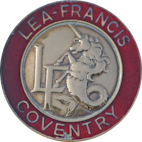
A revision of the C-Type, the D-Type was significant because it was the first production Lea-Francis fitted with a Meadows engine.
| Engine: | Meadows 4EB, 1247cc, 9.8hp 19bhp |
| Wheelbase: | 8' 0" |
| Track: | 3' 8" |
Charles Van Eugen’s most significant modification to the C type was to replace the Coventry Simplex engine with one newly designed and produced by Henry Meadows Ltd, this became the D type. The use of this engine signalled the start of a relationship with Meadows that was to last about ten years.
More or less identical to a C type, the D type consisted of a simple parallel rail chassis frame supported by semi-elliptic springs at the front and quarter-elliptic to the rear. The foot-brake operated drum brakes on the rear wheels only, with the handbrake operating on the transmission. The provision of two-wheel braking only was still common among motor manufacturers at this time, and was well able to cope with the 19bhp produced by the Meadows 4EB engine and an optimistic maximum speed of 50mph. Power was transmitted via a cone clutch and three-speed gearbox, also of Meadows manufacture, to a rear-axle housing a spur-gear differential. This differential was inherited from the C type design and was a fragile unit and prone to breakage even in the low-powered D type. Despite this, it was not until 1927 that Van Eugen managed to convince the directors of Lea-Francis to scrap it in preference for a stronger bevel-gear version to his own design.
For the later E type, Charles Van Eugen designed a new four-speed gearbox with a circular casing in aluminium and right-hand gear change, which was to be the standard for most subsequent Lea-Francis cars until the end of the 1920s. This gearbox became an option on later D types for customers not satisfied with the three speeds given by the Meadows unit.
Bodies for the D type were built by a number of companies, mainly by Robinson, Avon and Motor Bodies. Most of these cars were fitted with two and four-seat open bodies and a few with coupe and saloon bodywork. For the most part these cars were fitted with disc wheels although one or two more sporting versions had bolt on wire wheels. In 1923 the two-seater model sold for £235.
In a road test The Motor described the remarkable liveliness of this small 10hp car. A top speed of between 45 and 50mph was reported, with an average of 30mph said to have been maintained with ease. At this average speed the car returned a fuel consumption of 35 miles per gallon.
Approximately 420 D types were built, of which it is believed two have survived.
The D Type pictured here is a 1923 model and the only example owned by a Club member.



